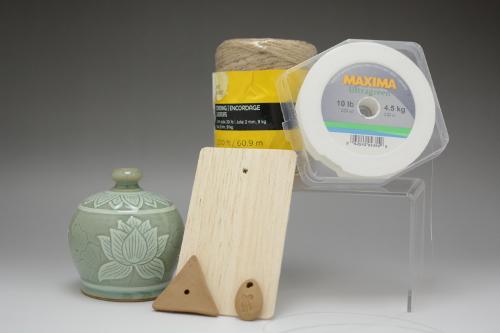tips
Being a potter is not only about making pots but also about meeting customer needs. It is important to let my customers know how to use and/or maintain my products. Here I have the following tips on ...
Fragrance Diffuser | French Butter Dish | Wind Chime
If you don't see what you're looking for, feel free to email me. I will do my best to address your questions.
I have been making miniature vases (or bud vases) for over three years. Most of my customers who purchased the vases from me know that they can also be used as fragrance diffusers (or also known as reed diffusers). My original intention of the vases was purely for little flowers until one of my customers said to me one day that she uses it as fragrance diffuser. That is how such an idea came about! : )
Some of you may be new to fragrance / reed diffusers so here I would like to share my experience with you as to where to buy the oil and reeds.
1. Reed Diffuser Oil:
- You can buy reed diffuser oil from the following shops:
- - Saje Natural Wellness
- - Escents Aromatherapy
- - Art Knapp
- - Pier 1 imports
- - Michaels
2. Reeds:
- I was surprised to learn that Saje only carry reed diffuser kits and not just reeds. Shops that carry reeds are:
- - Escents Aromatherapy
- - Art Knapp
- - Pier 1 imports
- - Michaels
- The number of reeds used in a diffuser depends on the opening of the miniature vase you purchased. I find roughly 7 reeds should be quite enough for diffusing the fragrance. The reeds should be roughly double the height of the vase. If you find the fragrance is not effectively diffused through the reeds after a few weeks, either it needs refill with more fragrance oil or it's time to replace with new reeds.
One important note is ... please keep the fragrance oil out of reach of children and animals.
Customers have been asking for French butter dishs (some call them 'butter bells') from me for the past two years and finally I'm proud to introduce them during Christmas in 2015 after many months of perfecting the size and shape and testing it out in my own kitchen.
Before that, I have no clue what a French butter dish is. After I created my very first working prototype and tried it out for months (and still using it now), I was amazed by it. Now I have spreadable butter for my toast every morning!
Now some of you (like myself) have never used a French butter dish before and are wondering how to use one properly. Here are the instructions as to how I use mine:
- Boil some water with a pinch of salt and let it cool. (I prefer to boil the water with salt so to further reduce the chance of bacteria growth.)
- Take one stick of butter (i.e. 1/2 cup) from the fridge and leave it on the counter to soften up. (I use Lactantia 'My Country' unsalted cultured butter which comes with 4 sticks in its package.)
- After the salted water is cooled, pour into the dish half full.
- Press the soften butter firmly into the lid. (The lid can fit one full stick of butter.)
- Place the lid onto the dish and leave it on kitchen counter away from sunlight and heat. (The butter will stay fresh and soft for about a month provided that you change the salted water once a week.)
Once all the butter are used up, simply wash the French butter dish in a dishwasher (Yes, my pottery can go into dishwasher!) and repeat the whole process again.
In a very hot summer day, add crushed or chipped ice into the dish so to keep the butter from melting.
For those customers who bought my wind chimes three years ago, it is probably about time to check on the string to see if it needs replacement. Here I would like to describe the process of re-stringing the wind chime. Below are the items which you will need in order to re-string your wind chime:
- Ceramic wind chime
- Ceramic striker
- Ceramic weight (for the windcatcher)
- Windcatcher (3 inches by 5 inches)
- Jute string (40 inches long)
- Fishing line (40 inches long)
Here's the image of the above items:

Below are the instructions I use when stringing all my wind chimes:
- Bring jute string and fishing line together by tying a knot at one end
- Measure roughly 18 inches away from the knot and bring the two together by tying another knot which will form a loop
- Pull the loop through the hole of the wind chime and tie a knot to prevent it from falling out of the wind chime
- Pull dangling end of the jute string (and fishing line) through the hole of the ceramic striker, position it so that it is just hidden within the wind chime and tie a knot underneath the striker to secure it
- Pull the dangling end of the jute string (and fishing line) through the hole of the windcatcher and ceramic weight, position them so that it is roughly 6 inches away from the striker and tie a knot to secure them
- Cut the remaining jute string (and fishing line)
If you would like to prevent the wind chime from singing too often, here are my suggestions:
- Adding more weight to the windcatcher
- Making the distance between the striker and windcatcher farther apart (e.g. 8-10 inches instead of 6)
Now the re-stringing is done!
On the other hand, you are more than welcome to bring your wind chime and other ceramic parts to my shows and my wife would be happy to re-string for you free of charge!




